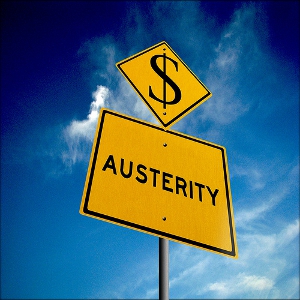 Since the beginning of the financial crisis in 2008 austerity has been the cornerstone of economic policies in the U.S. and Europe. In 2010, these policies were given a significant boost by the publication of research by Harvard University Professors Reinhart and Rogoff, which stated that cutting public spending to control deficits, would help to restart economic growth. Robert Pollin discusses new research which shows that several of Reinhart and Rogoff’s critical findings were incorrect. He argues that after compensating for the mistakes made, the data shows that that the relationship between growth and public debt varies widely over time and between countries, and that countries that are approaching a 90 percent ratio of public debt to GDP may not necessarily be at a danger point for economic growth.
Since the beginning of the financial crisis in 2008 austerity has been the cornerstone of economic policies in the U.S. and Europe. In 2010, these policies were given a significant boost by the publication of research by Harvard University Professors Reinhart and Rogoff, which stated that cutting public spending to control deficits, would help to restart economic growth. Robert Pollin discusses new research which shows that several of Reinhart and Rogoff’s critical findings were incorrect. He argues that after compensating for the mistakes made, the data shows that that the relationship between growth and public debt varies widely over time and between countries, and that countries that are approaching a 90 percent ratio of public debt to GDP may not necessarily be at a danger point for economic growth.
This article also appeared on the LSE’s USApp blog.
In 2010, the Harvard University economics professors Carmen Reinhart and Kenneth Rogoff published a paper in the American Economic Review, “Growth in a Time of Debt,” that spoke to the world’s biggest policy question: should we cut public spending to control the deficit or use the state to rekindle economic growth? This paper subsequently served as an important intellectual bulwark in support of austerity policies in the United States and Europe. It has been frequently cited by major economic policymakers, including the US Congressman Paul Ryan, the UK Chancellor George Osborne, and Olli Rehn, the leading economic official of the European Commission. Indeed, the Economics Nobel Laureate and New York Times columnist Paul Krugman observed that “Reinhart-Rogoff may have had more immediate influence on public debate than any previous paper in the history of economics.”
However, my co-authors Thomas Herndon and Michael Ash and I showed, initially in an April 2013 preliminary working paper of the Political Economy Research Institute (PERI) titled “Does High Public Debt Consistently Stifle Economic Growth,” that several of the critical findings advanced in the Reinhart-Rogoff paper were wrong. Our working paper set off an intense global debate through much of the spring of 2013, including multiple responses by Reinhart and Rogoff themselves, and rejoinders by my co-authors and I.

Now, in a final, fully refereed version of our paper, with the same title and published online in December 2013 with the Cambridge Journal of Economics, we examine these questions further, by expanding the range of our critique of the Reinhart-Rogoff research, and addressing the responses advanced by Reinhart and Rogoff in response to our initial working paper. Reinhart and Rogoff have referred to this debate as an “academic kerfuffle,” yet we think the debate has been constructive because it has brought greater clarity over the ideas shaping austerity policies in both the United States and Europe. We would welcome a formal substantive response by Reinhart and Rogoff to our published CJE paper.
The Reinhart-Rogoff research is best known for its result that, across a broad range of countries and historical periods, economic growth declines dramatically when a country’s level of public debt exceeds 90% of gross domestic product. Working with the Reinhart-Rogoff data set, we show that there is no evidence to support this claim.First, in their work with a sample of 20 advanced economies over 1946-2009, they report that average (i.e. the mean figure in formal statistical terms) annual GDP growth ranges between about 3% and 4% when the ratio of public debt to GDP is below 90%. But they claimed that average growth collapses to -0.1% when the ratio rises above a 90% threshold.
However, Herndon, Ash, and I show that these results were based on three sets of mistakes: (1) exclusion of some of the available data; (2) coding errors with their working Excel spreadsheet; and (3) inappropriate methods for averaging statistics to produce their overall results. For example, because of these data-handling problems, a one-year experience in New Zealand in 1951, during which economic growth was -7.6% and the public debt level was high, ends up exerting a major influence on their overall findings. Indeed, this 1951 experience in New Zealand exerted equal influence on their overall findings as 19 years in which the UK economy operated with high public debt/GDP ratios. The UK economy experienced postwar growth at an average rate of 2.4% over these 19 years.
When we performed accurate recalculations using Reinhart-Rogoff’s dataset, we found that, when countries’ debt-to-GDP ratio exceeds 90%, average growth is 2.2%, not -0.1%. We also found that the relationship between growth and public debt varies widely over time and between countries. For example, for the years 2000 to 2009, the average GDP growth rate for countries carrying public debt levels greater than 90% of GDP was either comparable to or higher than those for countries whose public debt/GDP ratios ranged between 30 and 90% .
In their response to our April 2013 working paper, Reinhart and Rogoff say that their incorrect GDP growth figures, based on average (i.e. mean) GDP growth rate calculations, were never what they had emphasized in any case, either in the 2010 paper itself or subsequently. They argued that they had always given more credence to the alternative measures of GDP growth reported in their 2010 paper, which are the median figures (medians being another way to measure central tendencies in data). Most importantly, they observed that, using either our corrected average figures or the medians from their 2010 paper, GDP growth declines by about one percentage point when the public debt/GDP ratio crosses the 90% threshold.
Yet there were serious problems with Reinhart and Rogoff’s response. The most obvious was that the median GDP growth figures they reported in their 2010 paper are distorted by the same errors that affected their average growth figures. Indeed, in an “Errata” memorandum responding to our working paper, when Reinhart-Rogoff themselves corrected their Excel coding error and included all the data for all countries in their spreadsheet, the differences in median economic growth rates falls by only 0.4 percentage points between countries whose public debt/GDP ratio was between 60-90% and those where the ratio was over 90%—from 2.9 to 2.5% median GDP growth. In other words, based on Reinhart-Rogoff’s own recalculations in their Errata memo, we actually see, with their preferred median figures, still stronger evidence that there is no significant drop off in growth when a country passes the 90% public debt/GDP threshold. Reinhart-Rogoff themselves do not highlight this result in their Errata memo.
Reinhart and Rogoff also initially defended their 2010 findings by referring to the results with their dataset spanning 220 years, from 1790-2009. However, as we show in our CJE paper, they made the same statistical errors generating these 220-year calculations, and their results are similarly distorted. For example, with the 1790-2009 data, a one-year experience in Norway in the 60-90% public debt/GDP category—when economic growth happened to be an exceptionally high 10.2%—is accorded equal weight with 23 years in Canada, 35 years for Austria, 42 years for Italy, and 47 for Spain. We show that when properly recalculated, there is no difference at all in the average GDP growth rates over 1790-2009 for the countries in Reinhart-Rogoff’s dataset in which public debt ranges between 90-120% relative to countries in which public debt/GDP fell between 60-90%.
What does our critique of the Reinhart-Rogoff research mean in terms of economic policy? Consider a situation in which a country is approaching the threshold of a 90% public debt/GDP ratio. It is simply not accurate to assume that these countries are reaching a danger point where economic growth is likely to decline precipitously.
Rather, our corrected evidence shows that a country’s growth may be somewhat slower once it moves past the 90% public debt-to-GDP level. But we cannot count on this being true under all, or even most, circumstances. Are we considering the US demobilization after World War II or New Zealand experiencing a severe one-year recession? Our evidence shows that one needs to ask these and similar questions, including whether slow growth was the cause or consequence of higher public debt, before we can draw meaningful conclusions.
More generally, as my co-authors and I write in concluding our CJE paper, “policymakers cannot defend austerity measures on the grounds that public debt levels greater than 90% of GDP will consistently produce sharp declines in economic growth.”
Note: This article originally appeared at the OUPblog and gives the views of the authors, and not the position of USApp– American Politics and Policy, nor of the London School of Economics. Please read our comments policy before commenting.
_________________________________
 Robert Pollin – University of Massachusetts-Amherst
Robert Pollin – University of Massachusetts-Amherst
Robert Pollin is Distinguished Professor of Economics at the University of Massachusetts-Amherst and Co-Director of the Political Economy Research Institute (PERI). He is the co-author of “Does high public debt consistently stifle economic growth? A critique of Reinhart and Rogoff” (available to read for free for a limited time) with Thomas Herndon and Michael Ash in the Cambridge Journal of Economics.







We agree that any investment (public or private) should pay for itself. It is blindingly obvious that an economically significant amount of public investment is made with the understanding that in will never pay for itself. Review the budget for virtually every major public transportation system, from Amtrak, to Dallas Area Rapid Transit (DART), and the proposed Cali Rail system. In FY 2012, Amtrak’s operating revenue covered 88% of operating expenses (excluding non-cash items), which Amtrak brags is the “highest passenger rail operating ratio in the United States. . . . .” http://www.amtrak.com/ccurl/345/484/ AmtrakFY13-Budget-Comprehensive-Business-Plan-w-appx-052413.pdf Mind you, Amtrak brags that its operating costs exceed operating revenues. Micro tells us to stop producing when the marginal cost exceeds marginal revenue. But this simple economic lesson does not stop this money losing train.
DART, a fairly typical local public transit authority, operates at a loss (operating costs exceed operating revenues), which means that capital costs are never recovered from operations and only part of operating costs are recovered from operating revenues. The financial plan for the Cali HS Rail system proposes that it will never recover the capital costs from operating revenue. Net operating profits are projected to cover .5% of funding sources ($238 million out of $51.2 billion). Good luck. The given, so to speak, is that public investments are often made with the expectation that they will never pay for themselves.
Keynesian theory then observes that Spending = Income (actually Revenue). But it does not follow from this accounting identity, as Keynes, PK, and like-minded economists suppose, that increasing spending necessarily increases income. This single-entry accounting identity is blind to the balance sheet effects on both parties at equality.
My analysis is implicit in both Minsky and Fisher: “The structure of an economic model that is relevant for a capitalist economy needs to include the interrelated balance sheets and income statements of the units of the economy. The principle of double entry bookkeeping, where financial assets are liabilities on another balance sheet and where every entry on a balance sheet has a dual in another entry on the same balance sheet, means that every transaction in assets requires four entries.” (Minsky p. 77). Spending=Income presents only two of the requisite four.
“The bookkeeping implications of such couples of items were discovered by accountants long ago and are the basis of their double entry bookkeeping, though its economic significance has been largely overlooked. One important significance is that this double entry prevents double counting; when we take the sum total of all income items for society, including psychic as well as physical items, this double entry results in cancelling out everything except the psychic items of enjoyment and labor pain.” (Fisher p. 20).
Back to the identity, Buyer Spending = Seller Income (Revenue). It is equally true that Seller Revenue = Net Income + Costs. It follows that when production costs exceed revenue, Seller Net Income is negative, and, as a result, Seller Net Worth and the Seller’s capacity to demand in ensuing cycles decline with every sale. Spending that induces ales below costs destroys aggregate demand from the supply side to the extent the producer-seller is forced by the losses and the resulting decline in the net worth on its balance sheet to reduce spending over one or more ensuing production cycles. Public spending that consumes more than it produces (bridges to nowhere, Amtrak, et al) likewise destroys the capacity to demand an output potential.
The single-entry accounting identity at the heart of the paradox of thrift supposes that spending (public or private) to induce production at a loss (Britain spending 2 pounds to produce coal it can sell for 1 pound) has the same economic effect as spending that induces production at a profit (revenue from outputs exceeds cost of inputs). But the economy can’t make up in volume what it loses on every sale.
The ratio of government debt to GDP is the wrong ratio for analyzing the effects of government debt on future economic growth. This ratio omits the critical variable that determines whether public loan expenditure helps or hinders future growth: the economic return on a given loan expenditure. Public loan expenditures invested in public assets that generate positive economic returns (e.g., a road that lowers transportation costs more than the cost to build and finance it) can contribute positively to future GDP, national income, and most importantly, future growth potential. Public loan expenditures used for consumption or invested in unproductive assets (e.g., a road to nowhere) drag down economic growth, reduce disposal incomes, and lower economic growth potential going forward. It’s not the size of the debt, in and of itself, that helps or hinders GDP growth but whether the assets purchased with generate returns (economic services) in excess of the debt incurred.
Nonsense. First, it’s blindingly obvious that any investment (public or private) should pay for itself: it should be viable. That is, so to speak, a given.
Put another way, there is no reason to increase public investment just because there is a recession.
The purpose of increased public spending (net of tax) in a recession is to increase TOTAL SPENDING: i.e. to increase demand. And that additional net spending can of course take the form of extra PRIVATE SPENDING if the deficit comes about as a result of tax cuts rather than public spending increases.
As to why that extra spending is funded by more government debt, I’m baffled. Certainly Keynes said that deficits can perfectly well be funded by new money rather than extra debt. That purpose of a deficit is to impart stimulus, so what’s the point of government borrowing, the effect of which is anti-stimulatory, i.e. deflationary?
How does an investment pay for itself when its output is made available for free? Increased tax take (from some network effects with the private economy) is nigh-on impossible to quantify (ex-ante) or verify (ex-post).
Increased demand will most unlikely result from increases in private spending (assuming constant public expenditure and reduced taxation) since the extra post-tax income will increasingly accrue to savers. This is particularly true if, as is commonly the case, the top rate of tax is cut first. These people will likely buy up the new public debt (someone must buy it), not spend.
The effect of government borrowing is neither anti-stimulatory nor deflationary. It is anti-inflationary. (And there is no stimulus in inflation.) Stimulus results from redistribution. Public expenditure, in all its guises, is almost always redistributative. Increasing public expenditure is hence stimulative. It is irrelevant how it is funded. (Well-designed) taxes can be just as stimulative as deficits.